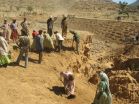NASA's SDO catches a double photobomb
2015-09-15
(Press-News.org) On Sept. 13, 2015, as NASA's Solar Dynamics Observatory, or SDO, kept up its constant watch on the sun, its view was photobombed not once, but twice. Just as the moon came into SDO's field of view on a path to cross the sun, Earth entered the picture, blocking SDO's view completely. When SDO's view of the sun emerged from Earth's shadow, the moon was just completing its journey across the sun's face.
Though SDO sees dozens of Earth eclipses and several lunar transits each year, this is the first time ever that the two have coincided. This alignment of the sun, moon and Earth also resulted in a partial solar eclipse on Sept. 13, visible only from parts of Africa and Antarctica.
SDO's orbit usually gives us unobstructed views of the sun, but Earth's revolution around the sun means that SDO's orbit passes behind Earth twice each year, for two to three weeks at a time. During these phases, Earth blocks SDO's view of the sun for anywhere from a few minutes to over an hour once each day.
You may notice that Earth's outline looks fuzzy, while the moon's is crystal-clear. This is because--while the planet itself completely blocks the sun's light--Earth's atmosphere is an incomplete barrier, blocking different amounts of light at different altitudes. On the other hand, the moon has no atmosphere, so during the transit we can clearly see the crisp edges of the moon's horizon.
INFORMATION:
[Attachments] See images for this press release:

ELSE PRESS RELEASES FROM THIS DATE:
2015-09-15
New research from the University of Washington's Friday Harbor Laboratories shows that a more acidic ocean can weaken the protective shell of a delicate alga. The findings, published Sept. 9 in the journal Biology Letters, come at a time when global climate change may increase ocean acidification.
The creature in question is Acetabularia acetabulum, commonly called the mermaid's wineglass. Reaching a height of just a few inches, this single-celled alga lives on shallow seafloors, where sunlight can still filter down for photosynthesis. Like many marine creatures, the ...
2015-09-15
UC San Francisco has received a National Cancer Institute grant of $5 million over the next five years to lead a massive effort to integrate the data from all experimental models across all types of cancer. The web-based repository is an important step in moving the fight against cancer toward precision medicine.
The goal is to accelerate cancer research to improve the way we diagnose, treat and conduct further research on the disease. The resulting database, called the Oncology Models Forum (OMF), will be accessible to researchers through the National Institutes of ...
2015-09-15
Current drugs may stop working against the most common type of brain tumor in children, medulloblastoma, but the tumor could be targeted in a new way, according to Stanford University scientists.
In research to be published in the journal eLife, a team led by Prof. Matthew P. Scott at the University's School of Medicine tested a drug called Roflumilast in mice with a brain tumor that is resistant to Vismodegib, the drug in current use. Roflumilast is normally used to treat inflammatory lung diseases. It dramatically inhibited tumor growth from the first day of treatment. ...
2015-09-15
This news release is available in French.
Montreal, September 15th 2015 - It is estimated that half of all cancer patients suffer from a muscle wasting syndrome called cachexia. Cancer cachexia impairs quality of life and response to therapy, which increases morbidity and mortality of cancer patients. Currently, there is no approved treatment for muscle wasting but a new study from the Research Institute of the McGill University Health Centre (RI-MUHC) and University of Alberta could be a game changer for patients, improving both quality of life and longevity. The ...
2015-09-15
To better inform the tradeoffs involved in land use choices around the world, experts have assessed the value of ecosystem services provided by land resources such as food, poverty reduction, clean water, climate and disease regulation and nutrients cycling.
Their report today estimates the value of ecosystem services worldwide forfeited due to land degradation at a staggering US $6.3 trillion to $10.6 trillion annually, or the equivalent of 10-17% of global GDP.
Furthermore, the problem threatens to force the migration of millions of people from affected areas. ...
2015-09-15
Solar energy is abundantly available globally, but unfortunately not constantly and not everywhere. One especially interesting solution for storing this energy is artificial photosynthesis. This is what every leaf can do, namely converting sunlight to chemical energy. That can take place with artificial systems based on semiconductors as well. These use the electrical power that sunlight creates in individual semiconductor components to split water into oxygen and hydrogen. Hydrogen possesses very high energy density, can be employed in many ways and could replace fossil ...
2015-09-15
Amsterdam, NL, September 9, 2015 - The potential benefits of dietary cocoa extract and/or its final product in the form of chocolate have been extensively investigated in regard to several aspects of human health. Cocoa extracts contain polyphenols, which are micronutrients that have many health benefits, including reducing age-related cognitive dysfunction and promoting healthy brain aging, among others.
Dr. Giulio Maria Pasinetti, MD, PhD, Saunders Family Chair and Professor of Neurology at the Icahn School of Medicine at Mount Sinai, Director of Biomedical Training ...
2015-09-15
OAK BROOK, Ill. - Imaging patients soon after traumatic brain injury (TBI) occurs can lead to better (more accurate) detection of cerebral microhemorrhages, or microbleeding on the brain, according to a study of military service members, published online in the journal Radiology.
Cerebral microhemorrhages occur as a direct result of TBI and can lead to severe secondary injuries such as brain swelling or stroke. The ability to monitor the evolution of microhemorrhages could provide important information regarding disease progression or recovery.
According to the Centers ...
2015-09-15
CHARLOTTESVILLE, VA (SEPTEMBER 15, 2015). Management of Myelomeningocele Study (MOMS) investigators analyzed updated data on the effects of prenatal myelomeningocele closure on the need for placement of a cerebrospinal fluid (CSF) shunt within the first 12 months of life. These researchers reaffirm the initial MOMS finding that prenatal repair of a myelomeningocele results in less need for a shunt at 12 months and introduce the new finding that prenatal repair reduces the need for shunt revision in those infants who do require shunt placement. The researchers also found ...
2015-09-15
In what is believed to be the largest, most detailed study of its kind in the United States, scientists at NYU Langone Medical Center and elsewhere have confirmed that tiny chemical particles in the air we breathe are linked to an overall increase in risk of death.
The researchers say this kind of air pollution involves particles so small they are invisible to the human eye (at less than one ten-thousandth of an inch in diameter, or no more than 2.5 micrometers across).
In a report on the findings, published in the journal Environmental Health Perspectives online Sept. ...
LAST 30 PRESS RELEASES:
[Press-News.org] NASA's SDO catches a double photobomb





